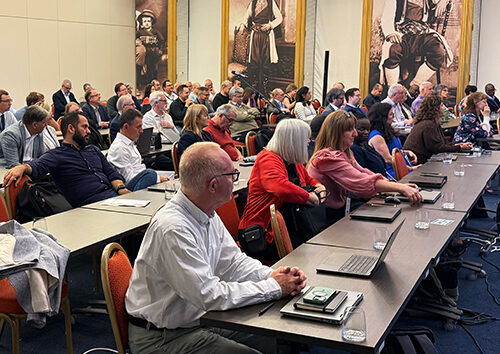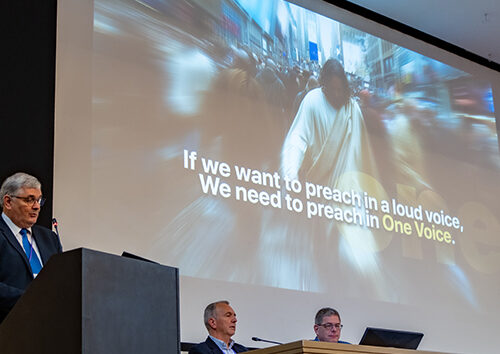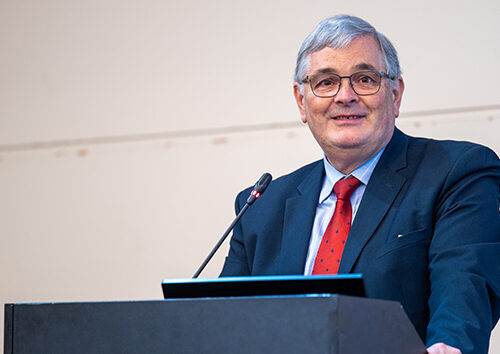5 July 2021 | Brussels, Belgium [ADRA Europe, Corrado Cozzi]
In cooperation with the Seventh-day Adventist Church in Europe, ADRA Europe organised the Art Contest to encourage young people to use their creativity to learn, understand, and support people forced to flee their country. On 19 June 2021, there was an online Award ceremony for the Art Contest “Hear me. See me. Walk with me.” About fifty participants took part, most of them children and their parents.
More than 40 children and young artists sent in their work to show their support to refugees. “It is the heart, the emotion, the simple feeling of solidarity of artworks that speak and goes beyond the limits of a written message,” affirmed the organisers.
Deana Stojković, Communications Assistant of the Trans-European Region (TED) hosted the programme with Corrado Cozzi, pastor and former Communication director of the Inter-European Region (EUD).
In his opening message, João Martins, Director of ADRA Europe, highlighted that in the same way God saw, heard and came down (Ex.3:7-8) when His people were refugees in Egypt, we must also Hear, See and Walk with refugees today. The work of God in favour of refugees is a masterpiece. By producing the beautiful masterpieces in the contest, participants collaborated with God in this mission of compassion for the oppressed.
Also present at the ceremony were Karen Holford, Children and Family Ministries director at TED and Elsa Cozzi, former Children’s Ministries at EUD.
“I was so inspired and moved by the wonderful pieces of art that the children and families created for the refugee art contest”, declared Karen Holford. “Each one of them conveyed different aspects of the challenging experiences of refugees, and each piece of art was beautifully unique and creative. Each child had taken the time to learn more about the lives of refugees, and that awareness will stay with them forever and expand as they grow. I hope that they will continue to speak up for the needs of refugees, advocate for them, and be compassionate towards them and that their work will encourage others to do the same,” Holford concluded.
Elsa Cozzi echoed: “We have refugees in every country we live in. If we are not refugees ourselves, it is just perchance, and someday, we may be obliged to endure such experience because life is full of uncertainties and unknown events.” Cozzi continues, “Let’s do our best to give voice, visibility and respect to the refugees that are among us. Most of them are only innocent victims of the worst facet of our world. Children are the most vulnerable and innocent victims of such a “crusade”. If they could choose, they would probably stay at home. Let’s show them respect and support as they try to integrate into a new environment and life, dealing with loads of terrible and horrific memories they collected on their way to us.”
Many churches around the world are doing a superb job to support refugees. For the last five years, the Adventist church and ADRA organised special programmes for a World refugee Sabbath. The question was: “Can we do more? Can we create a platform for easier understanding of the complex issue of migrations?”
Maja Ahac, Head of Advocacy at ADRA Europe, suggested contemplating and exploring the migration issue differently this year. “Young artists were kindly invited to prepare artworks that spoke about three specific topics. Each participant was welcome to explore thematics further with parents, teachers, friends, and the faith community. All around us live people who were forced to flee persecution, violence, hardship, war, etc. Refugees are often victims of conspiracy theories and are often abused by radical groups for political manipulations. With this art contest, we invited people to listen to refugees, think about the stories, put themselves into their shoes.”
World Refugee Sabbath shines a light on refugees’ rights, needs, and dreams, helping to mobilise resources so refugees can survive and thrive. It is celebrated on the Sabbath closest to 20 June, World refugee Day.
World Refugee Day is an international day designated by the United Nations to honour refugees around the globe. It celebrates the strength and courage of people who have been forced to flee their home country to escape conflict or persecution. World Refugee Day was held globally for the first time on 20 June 2001, commemorating the 50th anniversary of the 1951 Convention relating to the Status of Refugees. It was initially known as Africa Refugee Day before the United Nations General Assembly officially designated it as an international day in December 2000. Each year, World Refugee Day is marked by various events in many countries around the globe in support of refugees. These activities are led by or involve refugees themselves, government officials, host communities, companies, celebrities, school children, and the general public.
The jury examined the artworks and explained why outstanding pieces of art were chosen. Please, see the detailed explanation of awards below.
Aitana (Category 5-9 years): Aitana brought us a great concept, where on one side is a vast dry desert with a view to a small, desirable place with green pastures linked by a very narrow path. What better representation of a refugee’s struggle to pursue the dream of liberty and economic, social and political security?
Salina (Category 5-9 years): The work done by recycling materials brought to shore combined with a candle gives a powerful metaphor of the refugee’s struggles to get to a beach driven by hope for a better life.
Ana & Margarida (Category 10-14): Through drawings that move with the sound, Ana and Margarida’s work creatively remind us that usually, a story has a beginning and, sometimes, a happier ending.
Elizabeth (Category 15-18): Revealing a surprising technical mastery, Liz’s work draws our attention to the joy of learning, the right to a proper education that a lot of us take for granted, but some, despite the lack of opportunities and means, enjoy, appreciate and make the most of every single moment.
Saul (Category 19-25): Saul’s interview gives voice to one of the thousands of people that have to leave everything behind, searching for something better through a foggy sea of incertitude, where minor acts of kindness, empathy and support from the ones “on the other side” play a significant role for the change in their lives.
Mirilov (Category family): The Mirilovs’ poem subtly makes us travel the path of a diversity of ways to envision that simple life concept that drives individuals according to their different circumstances – the pursuit of happiness.
Bosquet-Roth (Category family): The water is the means that simultaneously “separate and connect” a boat full of hope represented by the butterflies to a vision of a more rewarding life represented by the children’s carefree enjoyment of the pool.
You can watch the live ceremony here.
To learn more about ADRA Europe, visit their website.
The original version of this article was first published on the Inter-European Division website.
[See also: Art Contest 2021 ‘Compassion for all’]
tedNEWS Staff: Victor Hulbert, editor; Deana Stojković, associate editor
119 St Peter’s Street, St Albans, Herts, AL1 3EY, England
E-mail: [email protected]
Website: www.ted.adventist.org
tedNEWS is an information bulletin issued by the communication department of the Seventh-day Adventist Church in the Trans-European Division. Readers are free to republish or share this article with appropriate credit including an active hyperlink to the original article.



